Engage NY Eureka Math 1st Grade Module 2 Lesson 24 Answer Key
Eureka Math Grade 1 Module 2 Lesson 24 Sprint Answer Key
A
*Write the missing number.
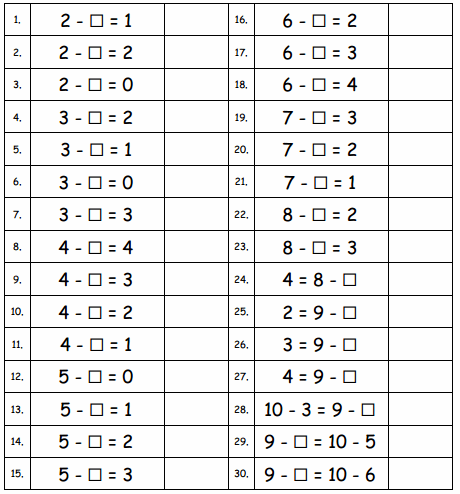
Answer:

Question 1.
2 – ☐ = 1
Answer:
2 – 1 = 1
Explanation:
Subtraction is an arithmetic operation that represents the operation of removing objects from a collection. The result of a subtraction is called a difference. Subtract one from two then we got one.
Question 2.
2 – ☐ = 2
Answer:
2 – 0 = 2
Explanation:
Subtraction is an arithmetic operation that represents the operation of removing objects from a collection. The result of a subtraction is called a difference. Subtract zero from two then we got two.
Question 3.
2 – ☐ = 0
Answer:
2 – 2 = 0
Explanation:
Subtraction is an arithmetic operation that represents the operation of removing objects from a collection. The result of a subtraction is called a difference. Subtract two from two then we got zero.
Question 4.
3 – ☐ = 2
Answer:
3 – 1 = 2
Explanation:
Subtraction is an arithmetic operation that represents the operation of removing objects from a collection. The result of a subtraction is called a difference. Subtract one from three then we got two.
Question 5.
3 – ☐ = 1
Answer:
3 – 2 = 1
Explanation:
Subtraction is an arithmetic operation that represents the operation of removing objects from a collection. The result of a subtraction is called a difference. Subtract two from three then we got one.
Question 6.
3 – ☐ = 0
Answer:
3 – 3 = 0
Explanation:
Subtraction is an arithmetic operation that represents the operation of removing objects from a collection. The result of a subtraction is called a difference. Subtract three from three then we got zero.
Question 7.
3 – ☐ = 3
Answer:
3 – 0 = 3
Explanation:
Subtraction is an arithmetic operation that represents the operation of removing objects from a collection. The result of a subtraction is called a difference. Subtract zero from three then we got three.
Question 8.
4 – ☐ = 4
Answer:
4 – 0 = 4
Explanation:
Subtraction is an arithmetic operation that represents the operation of removing objects from a collection. The result of a subtraction is called a difference. Subtract zero from four then we got four.
Question 9.
4 – ☐ = 3
Answer:
4 – 1 = 3
Explanation:
Subtraction is an arithmetic operation that represents the operation of removing objects from a collection. The result of a subtraction is called a difference. Subtract one from four then we got three.
Question 10.
4 – ☐ = 2
Answer:
4 – 2 = 2
Explanation:
Subtraction is an arithmetic operation that represents the operation of removing objects from a collection. The result of a subtraction is called a difference. Subtract two from four then we got two.
Question 11.
4 – ☐ = 1
Answer:
4 – 3 = 1
Explanation:
Subtraction is an arithmetic operation that represents the operation of removing objects from a collection. The result of a subtraction is called a difference. Subtract three from four then we got one.
Question 12.
5 – ☐ = 0
Answer:
5 – 5 = 0
Explanation:
Subtraction is an arithmetic operation that represents the operation of removing objects from a collection. The result of a subtraction is called a difference. Subtract five from five then we got zero.
Question 13.
5 – ☐ = 1
Answer:
5 – 4 = 1
Explanation:
Subtraction is an arithmetic operation that represents the operation of removing objects from a collection. The result of a subtraction is called a difference. Subtract four from five then we got one.
Question 14.
5 – ☐ = 2
Answer:
5 – 3 = 2
Explanation:
Subtraction is an arithmetic operation that represents the operation of removing objects from a collection. The result of a subtraction is called a difference. Subtract three from five then we got two.
Question 15.
5 – ☐ = 3
Answer:
5 – 2 = 3
Explanation:
Subtraction is an arithmetic operation that represents the operation of removing objects from a collection. The result of a subtraction is called a difference. Subtract two from five then we got three.
Question 16.
6 – ☐ = 2
Answer:
6 – 4 = 2
Explanation:
Subtraction is an arithmetic operation that represents the operation of removing objects from a collection. The result of a subtraction is called a difference. Subtract four from six then we got two.
Question 17.
6 – ☐ = 3
Answer:
6 – 3 = 3
Explanation:
Subtraction is an arithmetic operation that represents the operation of removing objects from a collection. The result of a subtraction is called a difference. Subtract three from six then we got three.
Question 18.
6 – ☐ = 4
Answer:
6 – 2 = 4
Explanation:
Subtraction is an arithmetic operation that represents the operation of removing objects from a collection. The result of a subtraction is called a difference. Subtract two from six then we got four.
Question 19.
7 – ☐ = 3
Answer:
7 – 4 = 3
Explanation:
Subtraction is an arithmetic operation that represents the operation of removing objects from a collection. The result of a subtraction is called a difference. Subtract four from seven then we got three.
Question 20.
7 – ☐ = 2
Answer:
7 – 5 = 2
Explanation:
Subtraction is an arithmetic operation that represents the operation of removing objects from a collection. The result of a subtraction is called a difference. Subtract five from seven then we got two.
Question 21.
7 – ☐ = 1
Answer:
7 – 6 = 1
Explanation:
Subtraction is an arithmetic operation that represents the operation of removing objects from a collection. The result of a subtraction is called a difference. Subtract six from seven then we got one.
Question 22.
8 – ☐ = 2
Answer:
8 – 6 = 2
Explanation:
Subtraction is an arithmetic operation that represents the operation of removing objects from a collection. The result of a subtraction is called a difference. Subtract six from eight then we got two.
Question 23.
8 – ☐ = 3
Answer:
8 – 5 = 3
Explanation:
Subtraction is an arithmetic operation that represents the operation of removing objects from a collection. The result of a subtraction is called a difference. Subtract five from eight then we got three.
Question 24.
4 = 8 – ☐
Answer:
4 = 8 – 4
Explanation:
Subtraction is an arithmetic operation that represents the operation of removing objects from a collection. The result of a subtraction is called a difference. Subtract four from eight then we got four.
Question 25.
2 = 9 – ☐
Answer:
2 = 9 – 7
Explanation:
Subtraction is an arithmetic operation that represents the operation of removing objects from a collection. The result of a subtraction is called a difference. Subtract seven from nine then we got two.
Question 26.
3 = 9 – ☐
Answer:
3 = 9 – 6
Explanation:
Subtraction is an arithmetic operation that represents the operation of removing objects from a collection. The result of a subtraction is called a difference. Subtract six from nine then we got three.
Question 27.
4 = 9 – ☐
Answer:
4 = 9 – 5
Explanation:
Subtraction is an arithmetic operation that represents the operation of removing objects from a collection. The result of a subtraction is called a difference. Subtract five from nine then we got four.
Question 28.
10 – 3 = 9 – ☐
Answer:
10 – 3 = 9 – 2
Explanation:
Subtraction is an arithmetic operation that represents the operation of removing objects from a collection. The result of a subtraction is called a difference. Subtract three from ten then we got seven. Subtract two from nine then we got seven. Both expressions are equal.
Question 29.
9 – ☐ = 10 – 5
Answer:
9 – 4 = 10 – 5
Explanation:
Subtraction is an arithmetic operation that represents the operation of removing objects from a collection. The result of a subtraction is called a difference. Subtract four from nine then we got five. Subtract five from ten then we got five. Both expressions are equal.
Question 30.
9 – ☐ = 10 – 6
Answer:
9 – 5 = 10 – 6
Explanation:
Subtraction is an arithmetic operation that represents the operation of removing objects from a collection. The result of a subtraction is called a difference. Subtract five from nine then we got four. Subtract six from ten then we got four. Both expressions are equal.
B
*Write the missing number.

Answer:

Question 1.
2 – ☐ = 2
Answer:
2 – 0 = 2
Explanation:
Subtraction is an arithmetic operation that represents the operation of removing objects from a collection. The result of a subtraction is called a difference. Subtract zero from two then we got two.
Question 2.
2 – ☐ = 1
Answer:
2 – 1 = 1
Explanation:
Subtraction is an arithmetic operation that represents the operation of removing objects from a collection. The result of a subtraction is called a difference. Subtract one from two then we got one.
Question 3.
2 – ☐ = 0
Answer:
2 – 2 = 0
Explanation:
Subtraction is an arithmetic operation that represents the operation of removing objects from a collection. The result of a subtraction is called a difference. Subtract two from two then we got zero.
Question 4.
3 – ☐ = 3
Answer:
3 – 0 = 3
Explanation:
Subtraction is an arithmetic operation that represents the operation of removing objects from a collection. The result of a subtraction is called a difference. Subtract zero from three then we got three.
Question 5.
3 – ☐ = 2
Answer:
3 – 1 = 2
Explanation:
Subtraction is an arithmetic operation that represents the operation of removing objects from a collection. The result of a subtraction is called a difference. Subtract one from three then we got two.
Question 6.
3 – ☐ = 1
Answer:
3 – 2 = 1
Explanation:
Subtraction is an arithmetic operation that represents the operation of removing objects from a collection. The result of a subtraction is called a difference. Subtract two from three then we got one.
Question 7.
3 – ☐ = 0
Answer:
3 – 3 = 0
Explanation:
Subtraction is an arithmetic operation that represents the operation of removing objects from a collection. The result of a subtraction is called a difference. Subtract three from three then we got zero.
Question 8.
4 – ☐ = 4
Answer:
4 – 0 = 4
Explanation:
Subtraction is an arithmetic operation that represents the operation of removing objects from a collection. The result of a subtraction is called a difference. Subtract zero from four then we got four.
Question 9.
4 – ☐ = 3
Answer:
4 – 1 = 3
Explanation:
Subtraction is an arithmetic operation that represents the operation of removing objects from a collection. The result of a subtraction is called a difference. Subtract one from four then we got three.
Question 10.
4 – ☐ = 2
Answer:
4 – 2 = 2
Explanation:
Subtraction is an arithmetic operation that represents the operation of removing objects from a collection. The result of a subtraction is called a difference. Subtract two from four then we got two.
Question 11.
4 – ☐ = 1
Answer:
4 – 3 = 1
Explanation:
Subtraction is an arithmetic operation that represents the operation of removing objects from a collection. The result of a subtraction is called a difference. Subtract three from four then we got one.
Question 12.
5 – ☐ = 5
Answer:
5 – 0 = 5
Explanation:
Subtraction is an arithmetic operation that represents the operation of removing objects from a collection. The result of a subtraction is called a difference. Subtract zero from five then we got five.
Question 13.
5 – ☐ = 4
Answer:
5 – 1 = 4
Explanation:
Subtraction is an arithmetic operation that represents the operation of removing objects from a collection. The result of a subtraction is called a difference. Subtract one from five then we got four.
Question 14.
5 – ☐ = 3
Answer:
5 – 2 = 3
Explanation:
Subtraction is an arithmetic operation that represents the operation of removing objects from a collection. The result of a subtraction is called a difference. Subtract two from five then we got three.
Question 15.
5 – ☐ = 2
Answer:
5 – 3 = 2
Explanation:
Subtraction is an arithmetic operation that represents the operation of removing objects from a collection. The result of a subtraction is called a difference. Subtract three from five then we got two.
Question 16.
6 – ☐ = 3
Answer:
6 – 3 = 3
Explanation:
Subtraction is an arithmetic operation that represents the operation of removing objects from a collection. The result of a subtraction is called a difference. Subtract three from six then we got three.
Question 17.
6 – ☐ = 4
Answer:
6 – 2 = 4
Explanation:
Subtraction is an arithmetic operation that represents the operation of removing objects from a collection. The result of a subtraction is called a difference. Subtract two from six then we got four.
Question 18.
6 – ☐ = 5
Answer:
6 – 1 = 5
Explanation:
Subtraction is an arithmetic operation that represents the operation of removing objects from a collection. The result of a subtraction is called a difference. Subtract one from six then we got five.
Question 19.
7 – ☐ = 4
Answer:
7 – 3 = 4
Explanation:
Subtraction is an arithmetic operation that represents the operation of removing objects from a collection. The result of a subtraction is called a difference. Subtract three from seven then we got four.
Question 20.
7 – ☐ = 3
Answer:
7 – 4 = 3
Explanation:
Subtraction is an arithmetic operation that represents the operation of removing objects from a collection. The result of a subtraction is called a difference. Subtract four from seven then we got three.
Question 21.
7 – ☐ = 2
Answer:
7 – 5 = 2
Explanation:
Subtraction is an arithmetic operation that represents the operation of removing objects from a collection. The result of a subtraction is called a difference. Subtract five from seven then we got two.
Question 22.
8 – ☐ = 3
Answer:
8 – 5 = 3
Explanation:
Subtraction is an arithmetic operation that represents the operation of removing objects from a collection. The result of a subtraction is called a difference. Subtract five from eight then we got three.
Question 23.
8 – ☐ = 4
Answer:
8 – 4 = 4
Explanation:
Subtraction is an arithmetic operation that represents the operation of removing objects from a collection. The result of a subtraction is called a difference. Subtract four from eight then we got four.
Question 24.
5 = 8 – ☐
Answer:
5 = 8 – 3
Explanation:
Subtraction is an arithmetic operation that represents the operation of removing objects from a collection. The result of a subtraction is called a difference. Subtract three from eight then we got five.
Question 25.
3 = 9 – ☐
Answer:
3 = 9 – 6
Explanation:
Subtraction is an arithmetic operation that represents the operation of removing objects from a collection. The result of a subtraction is called a difference. Subtract six from nine then we got three.
Question 26.
4 = 9 – ☐
Answer:
4 = 9 – 5
Explanation:
Subtraction is an arithmetic operation that represents the operation of removing objects from a collection. The result of a subtraction is called a difference. Subtract five from nine then we got four.
Question 27.
5 = 9 – ☐
Answer:
5 = 9 – 4
Explanation:
Subtraction is an arithmetic operation that represents the operation of removing objects from a collection. The result of a subtraction is called a difference. Subtract four from nine then we got five.
Question 28.
10 – 4 = 9 – ☐
Answer:
10 – 4 = 9 – 3
Explanation:
Subtraction is an arithmetic operation that represents the operation of removing objects from a collection. The result of a subtraction is called a difference. Subtract four from ten then we got six. Subtract three from nine then we got six. Both expressions are equal.
Question 29.
9 – ☐ = 10 – 6
Answer:
9 – 5 = 10 – 6
Explanation:
Subtraction is an arithmetic operation that represents the operation of removing objects from a collection. The result of a subtraction is called a difference. Subtract five from nine then we got four. Subtract six from ten then we got four. Both are equal expressions.
Question 30.
9 – ☐ = 10 – 5
Answer:
9 – 4 = 10 – 5
Explanation:
Subtraction is an arithmetic operation that represents the operation of removing objects from a collection. The result of a subtraction is called a difference. Subtract four from nine then we got five. Subtract five from ten then we got five. Both are equal expressions.
Eureka Math Grade 1 Module 2 Lesson 24 Problem Set Answer Key
Read the word problem.
Draw and label.
Write a number sentence and a statement that match the story.
Question 1.
Jose sees 11 frogs on the shore. Some of the frogs hop into the water. Now, there are 8 frogs on the shore. How many frogs hopped into the water?
Answer:
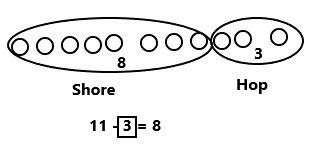
3 frogs hopped into the water.
Explanation:
Jose sees 11 frogs on the shore. Some of the frogs hop into the water. Now, there are 8 frogs on the shore. In the above image we can observe eleven circles for eleven frogs. Then circle eight frogs on the shore and label it as shore. The rest of the frogs are hopped into the water and label it as hop . Three frogs are hooped into the water. Circle this part too. This make it easier to see both parts. The number sentence is 11 – 3 = 8.
Question 2.
Cameron gives some of his apples to his sister. He still has 9 apples left. If he had 15 apples at first, how many apples did he give to his sister?
Answer:
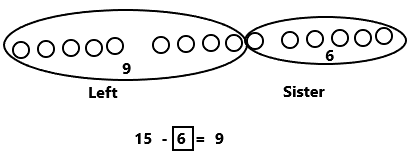
Cameron gave six apples to his sister.
Explanation:
Cameron had 15 apples. Cameron gives some of his apples to his sister. He still has 9 apples left. In the above image we can observe fifteen circles for fifteen apples. Circle nine of them. These are the nine apples left and label it as left. Some of the apples given to his sister and label it as sister. Six apples given to his sister. Circle this part too. This make it easier to see both parts. The number sentence is 15- 6 = 9. Cameron gave six apples to his sister.
Question 3.
Molly had 16 books. She loaned some to Gia. How many books did Gia borrow if Molly has 8 books left?
Answer:
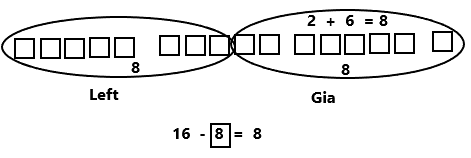
Molly gave 8 books to Gia.
Explanation:
Molly had 16 books. She loaned some to Gia. Molly has 8 books left. In the above image we can observe sixteen squares for sixteen books. Then circle eight of them. Label them as left. These are the eight books left. The rest are the books Gia loaned, so there are eight books loaned by Gia. Label it as Gia. Make a circle to this part also. This make easier to see both parts. The number sentence is 16 – 8 = 8. Molly gave eight books to Gia.
Question 4.
Eighteen baby goats were playing outside. Some went into the barn. Nine stayed outside to play. How many baby goats went inside?
Answer:

9 baby goats went inside.
Explanation:
Eighteen baby goats were playing outside. Some went into the barn. Nine stayed outside to play. In the above image we can observe eighteen circles for eighteen baby goats. Then circle Nine of them. Label them as outside. These are the nine goats stayed outside to play. The rest of the baby goats went into the barn, so there are nine goats went into the barn. Label it as inside. Make a circle to this part also. This make easier to see both parts. The number sentence is 18 – 9 = 9. Nine baby goats went inside.
Meet with a partner and share your drawings and sentences. Talk with your partner about how your drawing tells the story.
Eureka Math Grade 1 Module 2 Lesson 24 Exit Ticket Answer Key
Read the word problem.
Draw and label.
Write a number sentence and a statement that matches the story.
There were 18 dogs splashing in a puddle. Some dogs left. There are 9 dogs still splashing in the puddle. How many dogs are left?
Answer:

9 dogs left the puddle.
Explanation:
There were 18 dogs splashing in a puddle. Some dogs left. There are 9 dogs still splashing in the puddle. In the above image we can observe eighteen circles for eighteen dogs. Then circle Nine of them. Label them as still splashing. These are the nine dogs splashing in a puddle. Some of the dogs left the puddle, so there are nine dogs left the puddle. Label it as left. Make a circle to this part also. This make easier to see both parts. The number sentence is 18 – 9 = 9. Nine dogs left the puddle.
Eureka Math Grade 1 Module 2 Lesson 24 Homework Answer Key
Read the word problem.
Draw and label.
Write a number sentence and a statement that matches the story.
Question 1.
Toby dropped 12 crayons on the classroom floor. Toby picked up 9 crayons. Marnie picked up the rest. How many crayons did Marnie pick up?
Answer:
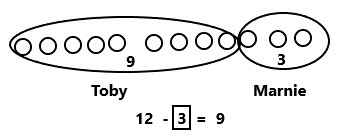
Marnie picked 3 crayons.
Explanation:
Toby dropped 12 crayons on the classroom floor. Toby picked up 9 crayons. Marnie picked up the rest. In the above image we can observe twelve circles for twelve crayons on the classroom floor. Then circle Nine of them. Label them as Toby. These are the crayons picked by Toby. Marnie picked up rest of the crayons, so there are three crayons on the classroom floor picked by Marnie. Label it as Marnie. Make a circle to this part also. This make easier to see both parts. The number sentence is 12- 3= 9. Marnie picked three crayons.
Question 2.
There were 11 students on the playground. Some students went back into the classroom. If 7 students stayed outside, how many students went inside?
Answer:
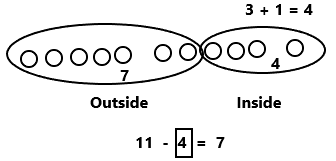
4 students went inside.
Explanation:
There were 11 students on the playground. Some students went back into the classroom. Seven students stayed outside. In the above image we can observe eleven circles for eleven students on the playground. Then circle seven of them. Label them as outside. These are the students stayed outside. Some students went back into the classroom, so there are four students went back into the classroom. Label it as inside. Make a circle to this part also. This make easier to see both parts. The number sentence is 11 – 4 = 7. Four students went inside.
Question 3.
At the play, 8 students from Mr. Frank’s room got a seat. If there were 17 children from Room 24, how many children did not get a seat?
Answer:
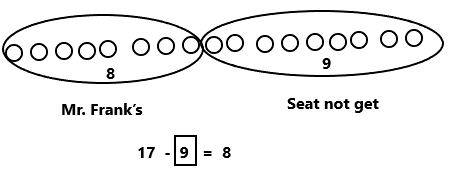
9 children did not get a seat.
Explanation:
At the play, 8 students from Mr. Frank’s room got a seat. There were 17 children from Room 24. In the above image we can observe seventeen circles for seventeen children. Then circle eight of them. Label them as Mr. Frank’s. These are the students got a seat . Some Children did not get a seat, so there are eight children did not get a seat. Label it as seat not get. Make a circle to this part also. This make easier to see both parts. The number sentence is 17 – 9 =8. Nine children did not get a seat.
Question 4.
Simone had 12 bagels. She shared some with friends. Now, she has 9 bagels left. How many did she share with friends?
Answer:
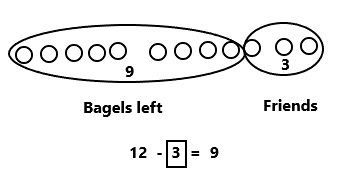
Simone shared 3 bagels with her friends.
Explanation:
Simone had 12 bagels. She shared some with friends. Now, she has 9 bagels left. In the above image we can observe twelve circles for twelve bagels. Then circle nine of them. Label them as Bagels left. These are the bagels left with Simone. She shared some bagels with her friends, so there are three friends. Label it as friends. Make a circle to this part also. This make easier to see both parts. The number sentence is 12 – 3 = 9. Simone shared three bagels with her friends.